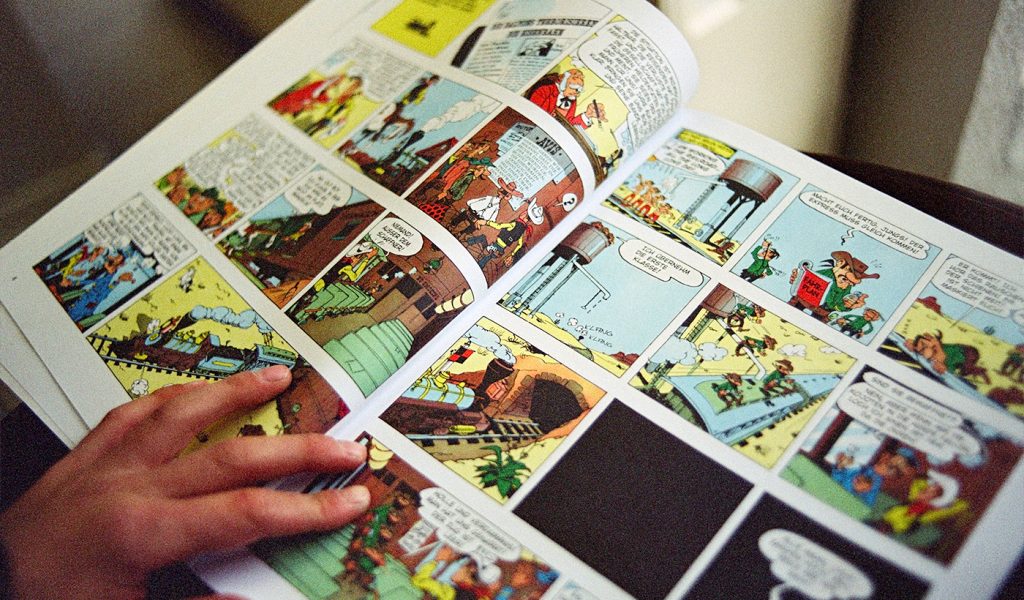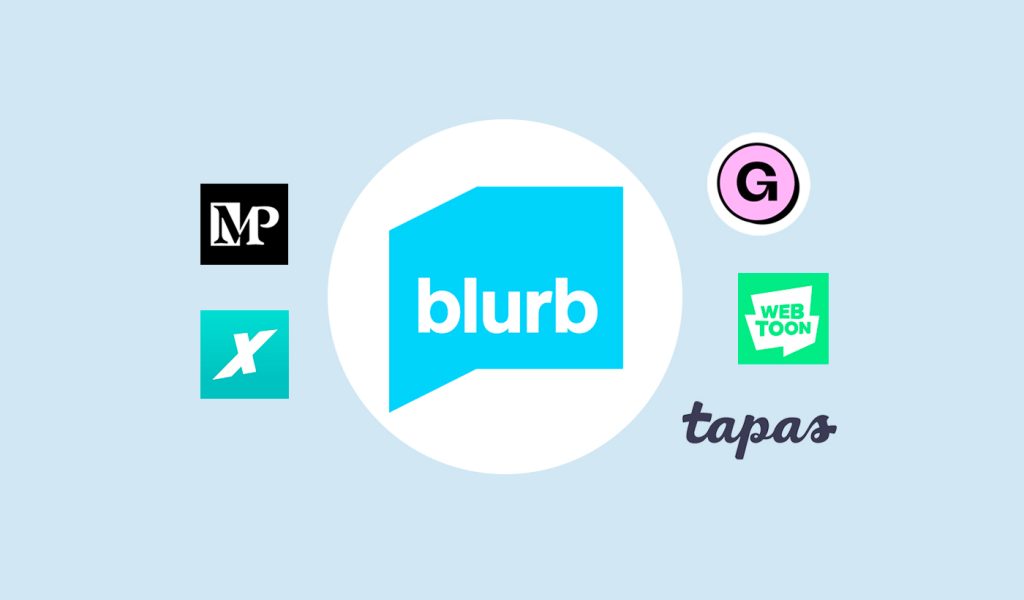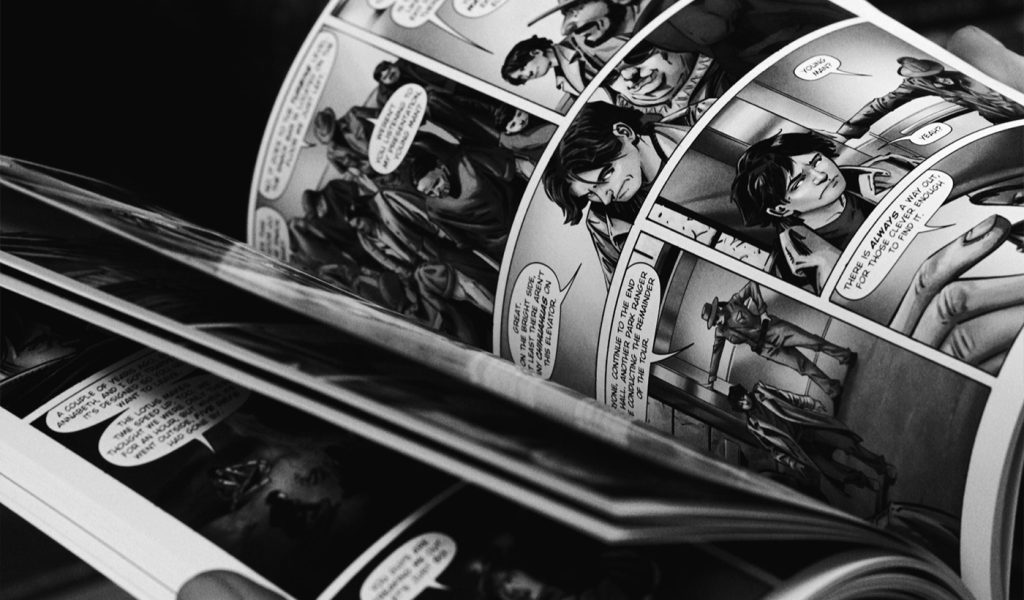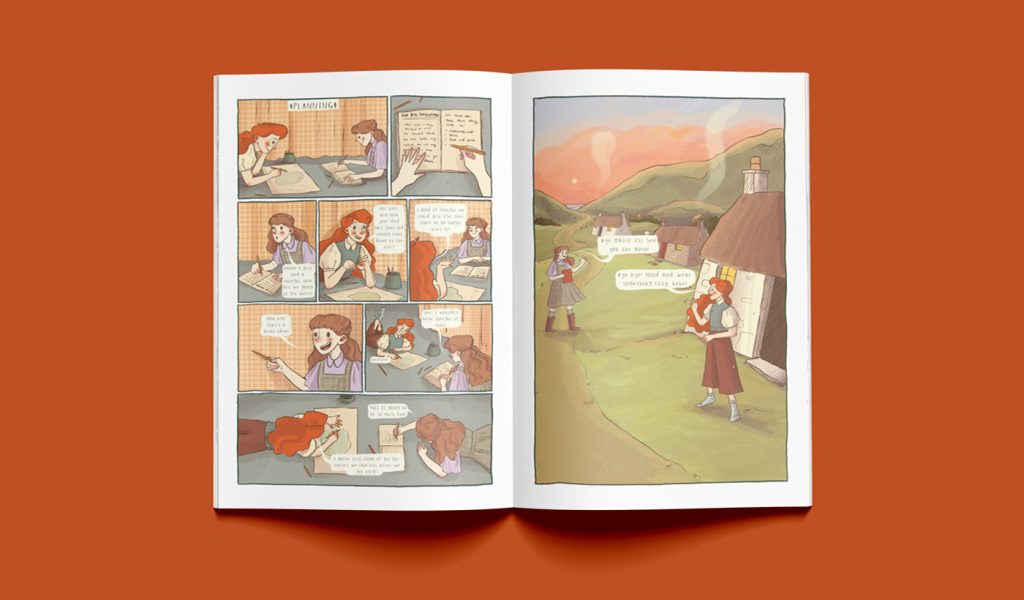How to self-publish a comic book: the go-to guide for independent comic creators
In the imaginative realm of storytelling, few mediums captivate us as profoundly as comic books. With their unique blend of stunning artwork and engaging narratives, these sequential art forms can transport us to extraordinary worlds, introduce us to inspiring characters, and ignite our creativity like no other.
As a comic book writer, you’re constantly exploring various graphic novels and comics—some of which may be ready to publish and share with the world. If you’re still getting started, we suggest checking out this post on how to start a comic book, which provides a step-by-step process for beginning.
This guide focuses on how to self-publish a comic book, taking you from finalizing your art to printing and marketing your work. It may not be as fun as the creative process, but it’s crucial for turning your work into a finished product. Let’s dive in.
Benefits of self-publishing your comic book
Historically, getting your work published meant submitting your work to a major comic book publisher in hopes of sparking their interest. For many comic writers, this avenue was a distant long shot, limited to the best of the best and highly-regarded creators who already had a track record in the industry.
Nowadays, self-publishing platforms have lowered the barrier to entry, making it possible for anyone with a finished concept to publish a comic book. In addition to accessibility, the ability to self-publish your comic book comes with many benefits, including:
- Retaining creative control: Self-publishing allows you to take control of your creative process. From deciding on the story arc to depicting your characters with creative liberty, you to tell your story without constraints.
- Faster publishing times: Self-publishing typically results in faster publishing times than traditional publishing.
- Bigger return on investment: One of the most desirable benefits of self-publishing a comic book is keeping more of the profits. That’s because creators partnering with traditional publishers only receive a percentage of the sales.
- Complete ownership: Unlike traditional publishing, self-publishing means retaining complete ownership of the finished product, giving you complete creative and marketing control.
- More fulfilling endeavor: Although writing and designing comic books and graphic novels is time-consuming, it can be extremely fulfilling.
- Involvement in every aspect of the book’s production: Self-publishing means you’ll make decisions about every part of the book’s creation, from content to cover.
- Superior quality control: Some self-publishing platforms, such as Blurb, provide professional quality control and fast turn-around times, rivaling the finished product of major publishing companies.
Self-publishing gives creators complete control over every aspect of their comic book’s design and content. Likewise, cutting out middlemen, like book agents and publishers, means indie creators can keep more of the revenue generated from their work. It’s a no-brainer why so many creators are pursuing the control, liberty, and fulfillment of self-publishing.

Finalize your comic book
After countless hours of hard work creating your comic book, it’s time to finalize all the moving parts to get it ready for publishing. Here are some key considerations to help in finalizing your comic book before moving forward with self-publishing your work.
Determine your desired format type
The term “format” can have many meanings in the publishing world. But in this context, decide whether your comic book will be in digital form, printed copies, or a hybrid of both. In this guide, we emphasize printing physical copies. However, most of the advice applies to all formats and finished products.
Use the correct formatting
The other meaning behind the format focuses on layout and sizing. The arrangement of your book’s content should align with the dimensions of your desired book format. Blurb’s trade books, available in 5 by 8, 6 by 8, and 8 by 10 inches, match well with most comic book specs. The magazine format is also suitable if you want more page real estate.
The formatting of your comic book is crucial for a professional look and feel. Ensure all pages have consistent margins, font sizes, and panel spacing. Also, verify that all images are high-resolution for printing purposes. These formatting considerations are critical when assembling the final version of your comic book.
Edit and proofread
It’s wise to hire a copy editor or proofreader to review your comic book before you upload it for printing and distribution. Although you might be confident in your editing skills, getting a second set of eyes on your work pays dividends to ensure your book is polished and professional. In addition to correcting spelling and grammar mistakes, experienced editors help with word choice and fine-tuning the flow and delivery of your stories.
Design your comic book’s cover
If you’ve yet to create a cover for your comic book, this is a key box to check in finalizing your work. Your cover design should be eye-catching enough to attract potential readers while accurately representing your book’s content. Select an appropriate color scheme and imagery that showcases key characters and complements your story arc but doesn’t give too much away.
Decide how many copies you’ll need
You’ll want to determine how many copies to print based on demand or budget constraints. This decision helps determine what self-publishing platform to use if you’ve yet to select one. For instance, some platforms require a certain minimum amount, while other print-on-demand providers allow you to print single copies as needed.

Choose a self-publishing platform
There is no shortage of self-publishing platforms, each offering its own bookmaking tools, printing options, and distribution reach. Depending on the format and goals of your comic book, some platforms are more suitable than others. Here’s a breakdown of some of the most popular options, along with the pros and cons of each.
ComiXology
Now a brand under the Amazon umbrella, ComiXology is a popular digital comics platform. Amazon has created the Kindle Comic Creator tool specifically designed for independent comic book creators. It allows creators to publish their work digitally and reach a wide audience of comic book readers.
- Pros: Access to a large and established reader base; potential exposure to a broader audience; integration with Kindle devices and apps; royalty payments for sales.
- Cons: Unable to publish on other sites; no indie creator highlights on storefront; high cost; limited control over pricing.
Webtoon
Webtoon is a popular webcomic platform that offers a unique vertical scrolling format. Creators can publish their comics on Webtoon Canvas, gaining access to a large and engaged online community.
- Pros: Wide exposure to a dedicated readership; potential for viral reach and popularity; optimized for mobile viewing; potential to earn revenue through the Ad Revenue Sharing Program and Patreon integration.
- Cons: Primarily digital-focused; limited control over formatting due to the vertical scrolling format; more suited for ongoing serialized stories rather than traditional print editions.
Gumroad
Gumroad is a platform that enables independent creators to sell digital products directly to their audience. It supports self-publishing digital comic books and offers marketing and sales tools.
- Pros: Direct sales to your audience; flexibility in pricing and content; additional features for building a fan base and managing subscriptions; ability to sell digital and physical products.
- Cons: Less focused on the comic book market; self-promotion and marketing efforts required; limited discoverability on Gumroad’s platform.
Tapas
Tapas is a webcomic platform that allows creators to publish and monetize their comics. It offers a mix of free and premium content, providing opportunities for creators to earn revenue through ad revenue sharing and tipping.
- Pros: Access to a large and engaged readership; ability to earn revenue through ad revenue sharing, tipping, and premium content; opportunities for promotional features and contests.
- Cons: Primarily digital-focused; limited control over the pricing of premium content; potential competition with a large number of other creators for visibility.
Morris Publishing
Morris Publishing is a self-publishing platform tailored explicitly for comic book creators. It offers a range of services, including printing, distribution, and fulfillment, to help creators bring their comics to a physical audience.
- Pros: Focus on physical book printing and distribution; professional printing quality with customization options; assistance with distribution and fulfillment.
- Cons: Limited digital reach and discoverability; potentially higher upfront costs for printing and services; self-promotion required to build an audience.
Blurb
Blurb is a world-class self-publishing platform that supports various types of publications, including comic books. It provides easy-to-use tools and templates to create and publish your comic book in various print formats and across integrated distribution channels to sell your work.
- Pros: Flexibility to print physical copies on demand; fully-customizable layouts and designs; high-quality professional printing; the ability to sell through Amazon and Blurb’s bookstores.
- Cons: Comic book market is one of many supported types but not a core focus; self-promotion and marketing efforts are required to reach an audience.
If going the digital route, there can be advantages to choosing platforms specializing in comics. But if you want to print professional-quality hardcopies, utilizing the print-on-demand services at Blurb is a great option that many comic book creators choose.

Fund your comic book
If your comic book is more than just a hobby or passion project—it’s a business venture aimed at making money—then you’ll need sufficient funds to print and market your book. That’s where things get tricky! Here are the top ways to get your comic book or graphic novel into the market.
Crowdfunding platforms
Create a compelling Kickstarter campaign and offer backers rewards based on different pledge levels. Craft an engaging pitch, showcase sample artwork, and share your vision for the comic. Promote your campaign through social media, email newsletters, and engage with potential backers to generate interest.
Similar to Kickstarter, Indiegogo allows creators to launch crowdfunding campaigns. Utilize the platform’s tools and resources to create an engaging campaign page, reach out to your existing network, and connect with your new audience and backers.
Pre-sales and pre-orders
Offer pre-sales or pre-orders for your comic book through your website or online platforms like Gumroad, Big Cartel, or Shopify. Promote the opportunity to secure a copy of the book before its release, potentially with exclusive bonuses or limited editions to incentivize early purchases.
Depending on your audience, leverage social media and email marketing to generate buzz and direct potential readers to your pre-sales page. Stay engaged with your audience, provide updates, and create a sense of anticipation for your comic book release.
Patrons and subscription models
Establish a Patreon page or offer a subscription model through platforms like Gumroad or Tapas. Provide patrons or subscribers exclusive content, behind-the-scenes access, early previews, or bonus material. Regularly engage with your supporters and make them feel part of a community. Consider offering different tiers of membership or subscription levels with varying benefits and rewards to cater to supporter preferences.
Collaborations, sponsorships, and contests
Seek collaborations with brands or businesses that align with your comic book’s themes or target audience. This approach explores partnerships that can provide financial support, cross-promotion, or sponsorships to help fund your project. Engage with local businesses or organizations interested in supporting local artists and creators. Seek out potential sponsors or patrons willing to invest in your comic book.
Also, explore contests and awards that offer financial support or exposure to winners or finalists. Winning or recognition by these competitions provides validation and visibility for your work. Check out Script2Comic and Negative Space for contests that may be worth exploring.

Publishing your comic book
Once you’ve finalized your comic book and chosen the ideal platform, it’s time to submit your book and have it self-published. Each platform has its own process, but most will involve some combination of the following.
Create or upload your book
The content of your book should be finalized and ready to publish. Many platforms have proprietary tools for this. With Blurb, you can use its free bookmaking tool called Bookwright or sync with Adobe Photoshop, InDesign, and Lightroom to create your book. You can also upload a PDF of your book to have it published.
Choose your book size and paper type
Depending on your book’s format, choose from different styles and sizes, like 8 by 10 inch hardcover books for limited editions or 5 by 8 inch softcover books for affordable and portable comics. Remember to carefully select your paper type and printing options—there’s no reason to pay for full color if you are creating a black and white copy, but you’ll definitely want premium paper and premium color printing if you’re crafting a high-quality, full-color print edition.
Order a proof copy
A proof copy is a single copy of your book that allows you to review and make any necessary changes before ordering additional copies. If you plan to distribute your book, it’s standard practice in the printing world to order and review a proof copy to ensure it’s exactly how you want it. This is a good time to pass it around to friends and family to see who can find any errors before you print multiple copies or put it up for sale online.
Print on demand
Print-on-demand technology means books are printed as they are ordered, rather than all at once as larger traditional publishers do. Printing copies as needed eliminates the required resource for large inventories—not to mention figuring out how to ship your book to buyers. Unlike days past, print-on-demand doesn’t compromise on quality. Today, your finished product will match the pristine quality you’d expect from traditional publishing houses.
Set your price
Self-publishing a comic book allows you to determine the price of your book. In setting the price, take into account your publishing costs and any fees or percentages that distribution channels like Amazon take when your book is sold. Pricing can be tricky, so you’ll want to do a deep dive with our ultimate guide to pricing for self-published creators.
Market your comic book
Let’s get real. Marketing your comic book isn’t always easy. Yet, it’s crucial to make your book successful in an increasingly saturated space. Here are some of the best marketing and distribution strategies when self-publishing your comic book.
Build an online presence
There’s more than one way to create your web presence, but we recommend starting with a website. This could be a personal portfolio website to market yourself as an author or a fully-functional ecommerce store where people can buy your book.
Next, invest in building or growing your social media presence. Platforms like Twitter, Instagram, and Pinterest are effective for cultivating a following and promoting your comic book. You can also experiment with social media advertisting to raise awareness and generate traffic to your site.
Leverage distribution channels
This is where publishing through niche comic book platforms has its advantages. Platforms like ComiXology and Webtoon have strong track records in helping creators reach a broad audience of comic book readers. However, sometimes these platforms are limited to digital-only books.
Make sure you are harnessing the distribution potential of each of your sales channels, like Amazon, Ingram, and Blurb’s online bookstore. Many online retailers have ways to run ads and tips on optimizing your book’s descriptions so you can show up higher in search results. Do plenty of research and take advantage of these channel-specific marketing solutions.
Attend comic book conventions
Attending comic book conventions and events is a great way to meet prospective customers, connect with existing fans, network with other creators, and ultimately, sell your book. The comic book scene is a community of passionate people. So, attending in-person events is a powerful way to reach hyper-targeted audiences actively interested in exploring new comic books and emerging creators.
Work with online and offline retailers
Certain retail outlets, such as local bookstores, aren’t going to stock your book automatically. Typically, you must reach out, pitch your book, and secure valuable shelf space. You can also contact numerous online comic bookstores, some of which have local storefronts.
This is just the tip of the iceberg in marketing your comic book. Some creators build momentum by buying paid ads and media placements, offering free samples to generate interest and build a fanbase, or collaborating with other brands and influencers. Just keep your marketing efforts ethical and relevant to those you’re trying to reach.
How much does it cost to self-publish a comic book?
The cost of self-publishing a comic book depends on a range of factors, such as the book’s length, printing method, book size, paper choice, and marketing strategy. Of course, the cost of these factors weighs heavily on the publishing platform you choose and your overall project goals, as the options and quality of printing services can vary widely.
In general, the cost of self-publishing a comic book usually varies between a few hundred dollars to several thousand dollars. Hobbyists aiming to make a comic book for fun can fund their project for far less than creators looking to sell their book to the masses.
For instance, if you only need one copy at a time, Blurb’s print-on-demand allows you to publish your comic book for as low as $13.99 per book for a 5 by 8 inch paperback trade book format with up to 24 pages.
Conversely, volume print runs can reduce costs with bulk orders. This is advantageous for creators anticipating high demand for their work and substantial sales potential. However, this option is generally more suitable if you have significant marketing momentum and budgets in the thousands of dollars.
Self-published comic book creators examples
Creators ranging from creative enthusiasts to notable writers have used Blurb to self-publish their comic books. Here are a few of those creators and the work they’ve put out into the world.
Lauren Cohen

Artist and writer Lauren Cohen self-brands herself as the Other New Yorker, the underlying theme of her comic graphic novel. In addition to her new life and experiences in New York, Lauren’s 122-page comic book is a culmination of her relatable insecurities about life, current events, politics, feminism, loneliness, sex, and the art world.
Edgar Alanis

Graphic designer and illustrator Edgar Alanis tastefully combines the world of academic art history with hilarious comic narratives in his self-published comic book titled Nudes Nudes Nudes. Each chapter of the book retells the origin stories behind specific iconic nudes portrayed through art history, but in a way that brings humor and lightness to an otherwise extremely niche topic.
Morvern Anderson

Scottish illustrator and comic specialist Morvern Anderson is a talented artist whose work transports readers to another world. Her self-published book, The Wee Stravaigers, (“stravaiger” meaning one who wanders or strolls), is an adventurous story of two friends who explore an abandoned island filled with historic ruins and revelations. It’s an epic encapsulation of Morvern’s unbound storytelling capacity and artistic abilities.
Michael Johnson

French comic writer and illustrator Michael Johnson compiles his comic opera titled Success! into a dense 480-page book organized into multiple acts and scenes. Rich with comical characterization, hilarious storytelling, and extraordinary illustrations, Michael’s one-of-a-kind comic book is a true work of art and a testament to his creative potential.
Danna Feintuch

Equal parts creative exercise and therapeutic outlet to process her mother’s passing, Arlyne Feintuch’s Places I’ve Left My Mom is a short, 16-page self-published comic book that contains illustrations of the various places around the world where she left her mom. Available as a 5 by 8 inch softcover book, it’s the perfect example of how self-publishing your comic book can be kept simple.
Self-publish your comic book with Blurb
Ideal for all types of creators, Blurb is an easy-to-use online platform that allows you to design, publish, and sell your comic book across multiple distribution channels. Assemble your book using Blurb’s free design tool BookWright, or leverage popular tools like Adobe InDesign, Lightroom, and Photoshop that integrate seamlessly with Blurb. Blurb’s free and customizable templates make it simple to get started or take advantage of the PDF to book tool to turn already created comics in PDF form into a book.
When ready to publish, Blurb provides a complete range of custom format options, like pristine layflat books or more economical softcover format. Once published, you can sell and distribute your book through Amazon, Ingram, or Blurb’s Bookstore.

